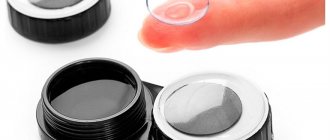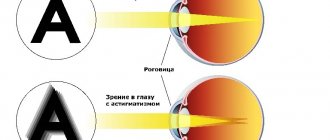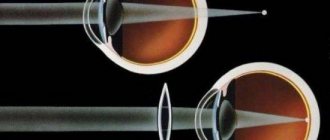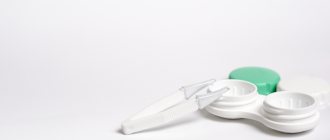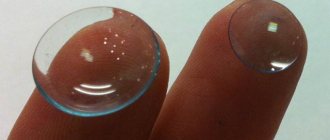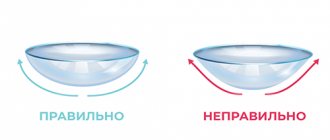You will be surprised to know that the first attempts to create lenses belong to Leonardo da Vinci! In 1508, he drew a sketch of a device that could be used to correct vision. According to the sketch, the optical device should be installed by eye, and most modern experts are confident that it was this that became the prototype of the contact products that are used today.
The invention of contact lenses has completely revolutionized people’s understanding of the correction of visual disorders; they allow you to feel freer and more confident.
The history of the creation of the first eye lenses
The story began with Da Vinci’s idea, and scientists continued to develop it:
Rene Descartes
1637: A French physicist and mathematician invented a device similar to a telescope. It was filled with water and a magnifying glass was inserted into it. Only the contact of the product with the eye is similar to a contact lens.
Thomas Young
1801: the Englishman Jung was able to improve Descartes' idea. The telescope tube became shorter, so the light rays were better focused on the retina. Wax was used for fastening.
John Herschel
An English scientist decided to systematize all the theoretical knowledge of the invention. Initially, he described the design of a corneal lens, and ten years later he proved that it was possible to treat astigmatism using the invented device. Herschel insisted that it should be transparent: glass or jelly-like, and most importantly, it was important to repeat the shape of the cornea of the gas.
Prerequisites for creating lenses
Master Leonardo was the first to speak about eye optics. In his experiments, he immersed the subject’s face in a bowl of water and he said that he saw better this way. No one knew then that water simply increases the acuity of peripheral vision.
In 1508, Leonardo created sketches depicting a proposed device for improving vision. The device looked like a balloon of water that was placed over the eyes. This was the prototype of the lenses.
Among Da Vinci's many followers was the French philosopher, mathematician and physicist René Descartes. He suggested using a tube of water with a magnifying glass at the end, which had to be fixed on the eyeball. And although in 1632 he put on this design himself, it turned out to be impossible to wear it.
It was uncomfortable, bulky, restricting movement. The glass quickly fogged up and nothing was visible. The tube made it difficult to blink, which led to dry corneas. The invention was considered dangerous and traumatic.
Descartes' device was improved by the English physicist Thomas Young, making the tube shorter. His followers, compatriots Siegrist and Lonstein, created hydroscopes based on this device.
They were intended to treat eyes with corneal disorders. Hydroscopes resembled a scuba diver's mask filled with water through which the patient had to look. Again, the device turned out to be cumbersome, and even led to maceration of the skin around the eyes when worn for a long time.
Another 200 years passed and a British scientist, physicist and astronomer John Herschel, returned to the problem of lenses. In his writings, he indicated that the main thing for a lens is to repeat the shape of the eye. In 1823, Herschel described the corneal lens in detail and provided a number of evidence indicating the feasibility of the idea in practice.
Essentially, he combined all the theories available at that time into one. After all, the scientists of that time had no idea what the correct lens would look like. It should correct vision and at the same time remain comfortable to wear.
When the first models were invented - the contributions of Fick, Kalt and Müller
The invention of the first products that were visible before our eyes is due to:
Master Adolf Fick
1888: The first contact glasses appeared thanks to the doctor Adolf Fick. The glass one weighed 0.5 grams. Later he created scleral ones, which were better attached to the eyes. The lenses were cast using plaster and casts of the eyes of corpses.
The tests were carried out first on animals, and later he conducted them on himself, studying and describing them in his textbook about adaptation and use.
Eugene Calt, 1888
In March 1888, Kalt announced that he had invented corneal products that treated keratoconus. They were not corneal, because were not completely transparent and rested on the sclera. And although they stayed firmly on the eyes, there was a minus - irritation of the eyelids.
August Müller, 1889
In 1889, Müller made a lens from a cast of the eye organ. Technology became the basis for his followers. Realizing that there was a problem - a lack of oxygen for the eyes, he filled the space between the glass and the eyes with water, but the cornea only swelled from this.
Carl Zeiss, 1913
In 1913, the factory of the German inventor began mass production of contact lenses. They were better than Muller's and were produced polished. Later, kits appeared and the doctor could select individual glasses for the patient: choose the optical power and size. It was not possible to wear it for a long time, because... caused hypoxia.
Glass shaped like an eye
130 years after this significant event, the French mathematician Rene Descartes proposed using a glass cylinder of water for the same purpose, attaching a magnifying glass to its end.
Another two hundred years later, in 1827, the English physicist and astronomer John Herschel first described a glass lens that follows the shape of the eye. And already in 1888, the German glassblower Friedrich Müller made the first glass sphere for his friend who had lost an eyelid. This glass completely covered the eye, protecting it from harmful environmental influences, and improved visual acuity. After his first successful experience, the glassblower began producing lenses for other clients. The lenses he blew completely followed the shape of the eye and were made in a two-color version. The white glass was adjacent to the white of the eye, and the transparent glass was adjacent to the iris and pupil.
At the beginning of the twentieth century, mass production of German glass contact lenses began. At that time, glass lenses were the crown of ophthalmology. However, they had significant disadvantages. The size of the glass shell did not allow the natural flow of oxygen to the cornea of the eye and over time caused serious problems for patients due to hypoxia.
How the first contact lenses were made
1913: Carl Zeiss's factory began mass production. “Corneal” models were still difficult to buy due to an unreliable fit. Until 1937, they were made glass, transparent in the iris area, white in the sclera area.
One of the first lenses
The difference between soft and hard lenses is discussed here.
1938: Americans Obrig and Mahler made the first synthetic plastic (called polymethyl methacrylate/PMMA) lenses. Their advantages were light weight, tight fit, and good “adhesion” to the mucosa. This made it possible to finally reduce the size to 12 mm.
1960 – the year of revolution in the world of contact lenses. Otto Wichterle, a Czech chemist, developed a polymer that could be saturated with moisture. Soft elastic films lay weightlessly on the surface of the eye. The material, called hydrogel, absorbed and retained up to 40% water. The problem of humidification and gas exchange was basically solved.
From this point on, lens innovation accelerated rapidly:
- 1978 – the first soft toric ones for the correction of astigmatism;
- 1979 – rigid gas-permeable;
- 1984 – the first colored ones (CibaVision);
- 1988 – soft planned replacements from Johnson & Johnson;
- 1999 – one-day silicone hydrogel;
- 2016 – water-gradient (2-3 times more humid);
- 2018 – bionic with built-in electronic circuits.
How and when contact lenses appeared. History of contact lenses.
No matter how surprising it may sound, attempts to create contact lenses were made at the end of the 16th century. And the first experiment belongs to Leonardo da Vinci himself. The archives remaining from the great master contain sketches from 1508, which depict a device intended for vision correction. According to the sketches, the optical system should be installed on the eye and correct vision. Today, scientists are confident that it was this invention of Leonardo that became the prototype of modern contact lenses.
However, the master’s invention did not find due recognition at that time and was safely forgotten for almost 400 years. It was only in 1887 that the German glassblower Friedrich Müller took advantage of Leonardo's idea. It all happened because one of Muller’s acquaintances did not have an eyelid, and to help the sufferer, a glass blower made a glass spherical lens and placed it on his eye. This lens protected the eye and prevented moisture loss. The patient wore this lens for 20 years, and with age-related changes in his vision, he began to notice that his eye could see better under the lens. After this, Muller began making such lenses, helping people with visual impairments. These lenses were prosthetic lenses that molded to the shape of the eye. The part of the lens that is adjacent to the sclera was made of white glass, and above the pupil was made of transparent glass.
Almost 30 years have passed and the company has established the production of special sets of contact lenses. Each set contained lenses with different parameters, this greatly facilitated the selection of lenses for the eyes of a particular person.
Until the mid-50s of the 20th century, all lenses were made of glass, and they had similar parameters, the diameter was 20-30 mm, and the thickness was 1-2 mm. These lenses covered almost the entire visible part of the eye, both the sclera and the cornea. Because of this, a large amount of fluid accumulated under them, which caused swelling of the cornea and pain in the patient. After patients removed their lenses, they had to undergo long-term treatment to restore corneal clarity.
A major breakthrough was the fact that in 1947, Kevin Touhey created the first small-diameter contact lens, it covered only the cornea, and was made of plastic, and not like glass before. It was after this that the contact lens became the shape it has now.
A new word in the production of contact lenses was the invention of the Czech scientist Otto Wichterle in the late fifties. He invented a transparent, stable polymer that is excellent for the production of soft contact lenses. This polymer had the ability to retain moisture and allow the eyes to “breathe”, and it did not cause swelling of the cornea. And since 1971, Wichterle’s invention has formed the basis for the mass production of contact lenses, making them accessible to everyone.
The history of the creation of a method of vision correction with lenses
With the precision of manufacturing, the possibilities for using lenses grew. From the initial treatment of myopia, which was very approximate, doctors moved on to the correction of farsightedness, age-related changes, and complex disorders.
The resolution has increased several times: today lenses are capable of correcting myopia of -35 diopters (this is impossible with glasses). Modern methods take into account not only the type of pathology, but also the patient’s lifestyle and occupation: there are ones for athletes, for IT engineers, for night wear. Read more about choosing night lenses here.
An experienced ophthalmologist, using a pair of films, simultaneously solves several problems, for example: a combination of presbyopia, astigmatism, myopia with different eye indicators.
Methods and technology for making contact lenses
5 manufacturing methods (or a combination thereof) have been developed and implemented:
Centrifugal molding
The monomer is poured into a bowl-shaped form, rotating at a certain speed, it is distributed over the surface and hardens. The hardened workpiece is taken out and saturated with water or hydrated. Next is the stage of computer photo control and sterilization. This is the cheapest method of producing lenses. The cheapest lenses are presented in this material.
Turning
On a high-precision machine, the required complex shape is turned from the workpiece. In this case, the temperature is + 22 degrees and humidity 45%. They make soft and hard lenses, and the method is 4-5 times more expensive than the centrifugal one.
Create by casting
Based on the matrix forms, copies are made, which harden under ultraviolet light. Next are the stages of polishing, hydration, tinting, quality control, sterilization, packaging and labeling. When polishing silicone hydrogel lenses, a special liquid and electric current are used.
You can understand how the selection of contact lenses according to parameters is carried out in the article.
Made by pressing
Occasionally, a production method that is no longer particularly popular, such as pressing, is used. This method is reminiscent of casting, only it is not the liquid monomer that is poured into the mold, but the already hardened polymer form that is pressed using specially prepared molds (dry pressing), or the form that has undergone hydration is immediately pressed.
Mixed – Reverse process 3
The front surface of the lenses is made by the centrifugal method and the surface is perfectly smooth, and the back surface is made by turning, which allows you to make any complex geometric shape.
The advantage is oxygen permeability, but the disadvantage is the long manufacturing process and high cost.
The convenience of wearing continuous wear lenses is described in the link.
Contact lenses in the USSR
The idea of creating contact lenses goes back to the distant past. Leonardo da Vinci also made drawings and some calculations for glasses that would be in full contact with the eyeball. More than one hundred and thirty years ago, the English physicist John Herschell proposed correcting vision with transparent gelatin shells filled with liquid, which would be placed on the cornea of the eye. In recent years, some foreign countries have begun to make contact lenses from glass and plastic, including colored lenses with diopters. In the Soviet Union, contact lenses are studied at the Helmholtz State Research Institute of Eye Diseases. To serve the population of our country, the institute trained doctors and opticians. They will work in contact lens laboratories, which are opening this year under the ministries of health in six cities - Minsk, Tbilisi, Baku, Tashkent, Kyiv and Riga. The head of the laboratory of contact lenses at the Helmholtz Institute, Elena Mikhailovna Orlova, says: “Even when we master their production, contact lenses will not be worn by everyone with poor vision. Regular glasses are easier to use: take them off and put them on. Lenses require more careful handling, as they must be placed on the eyeball under the eyelids. They are afraid of high temperatures. You must learn to put them on under the supervision of a doctor. Wearing them continuously for more than 6-8 hours is not recommended. However, in some cases, contact lenses are irreplaceable. For example, when working in a mine, ordinary glasses quickly become covered with dust; in the Far North, their glasses quickly sweat from the cold, and are completely unusable under water. Acrobats cannot perform in the circus with ordinary glasses, actors, singers, ballerinas cannot perform in the theater, or athletes can participate in competitions. Lenses are made to order. There is a special set of 150 lenses of various shapes. Each lens is tried on separately for each eye. Choose the two most suitable ones. Two exact copies are made from them. The technology for making contact lenses is time-consuming and requires pinpoint precision. A small transparent plastic plate heats up. When it softens, it is applied to a plaster cast made from the lens chosen for the eye and placed under a press. The resulting exact plastic copy of the lens is processed on machines: its edges and inner surface are ground and polished. After this, the lens is tried on the patient's eye. But he doesn’t see anything in it yet, since the optical part of the lens is not yet finished. This is a fitting. The laboratory assistant is observing, okay. does the plastic copy of the lens fit, does it irritate the eyeball somewhere? If there are deficiencies in some places, they are eliminated immediately, in the presence of the patient. Such painstaking fitting is carried out for many days: until then. until the pain stops feeling the lens on the eye. And only after this, the optical system that corrects vision is created manually on an optical machine on the lenses. Even close up it is difficult to see these lenses: they are only slightly betrayed by the stronger than usual shine of the eyes. The laboratory also has very tiny so-called “floating lenses” slightly larger than the pupil. They are made in the same way as large ones, on an individual basis.
Technology - youth 1959 No. 04
diet house made of timber
